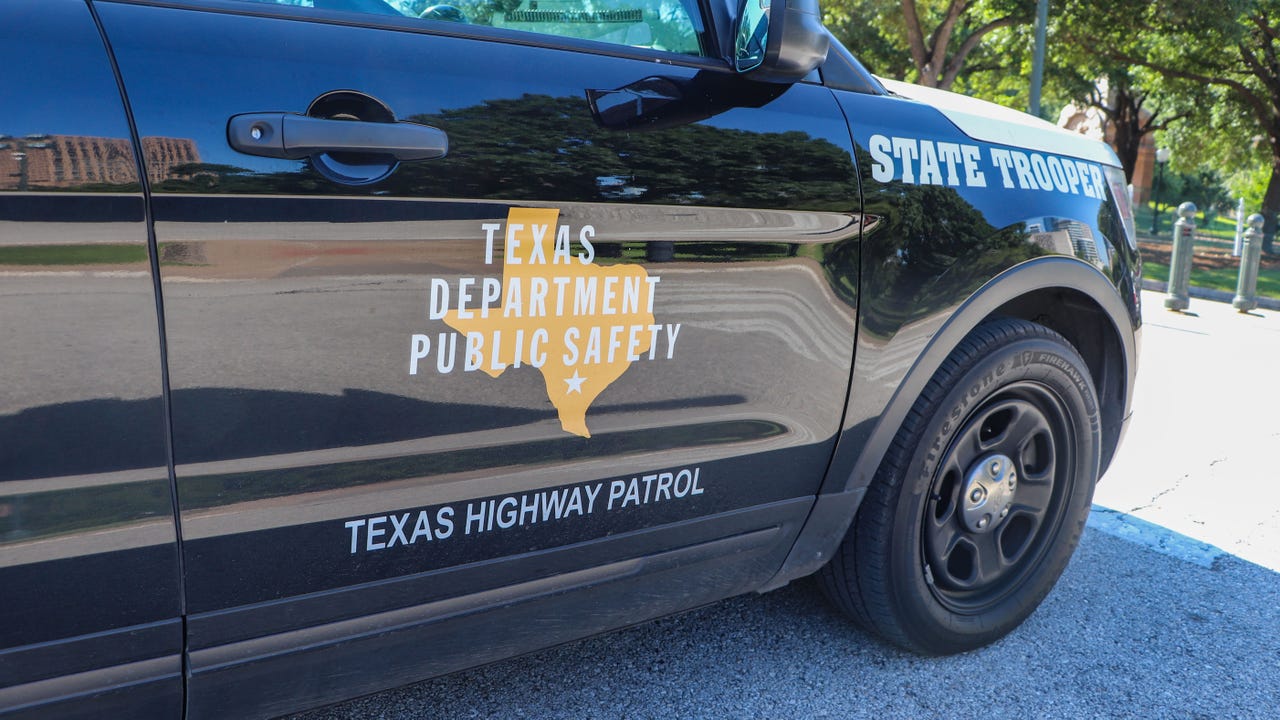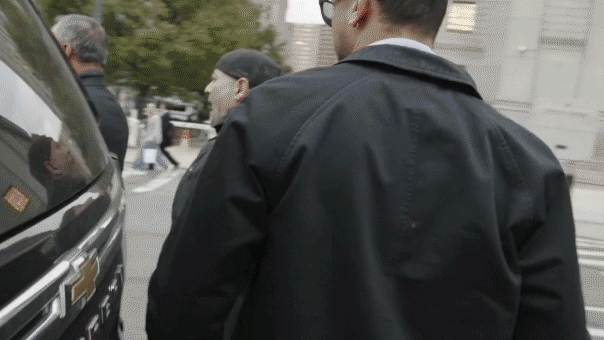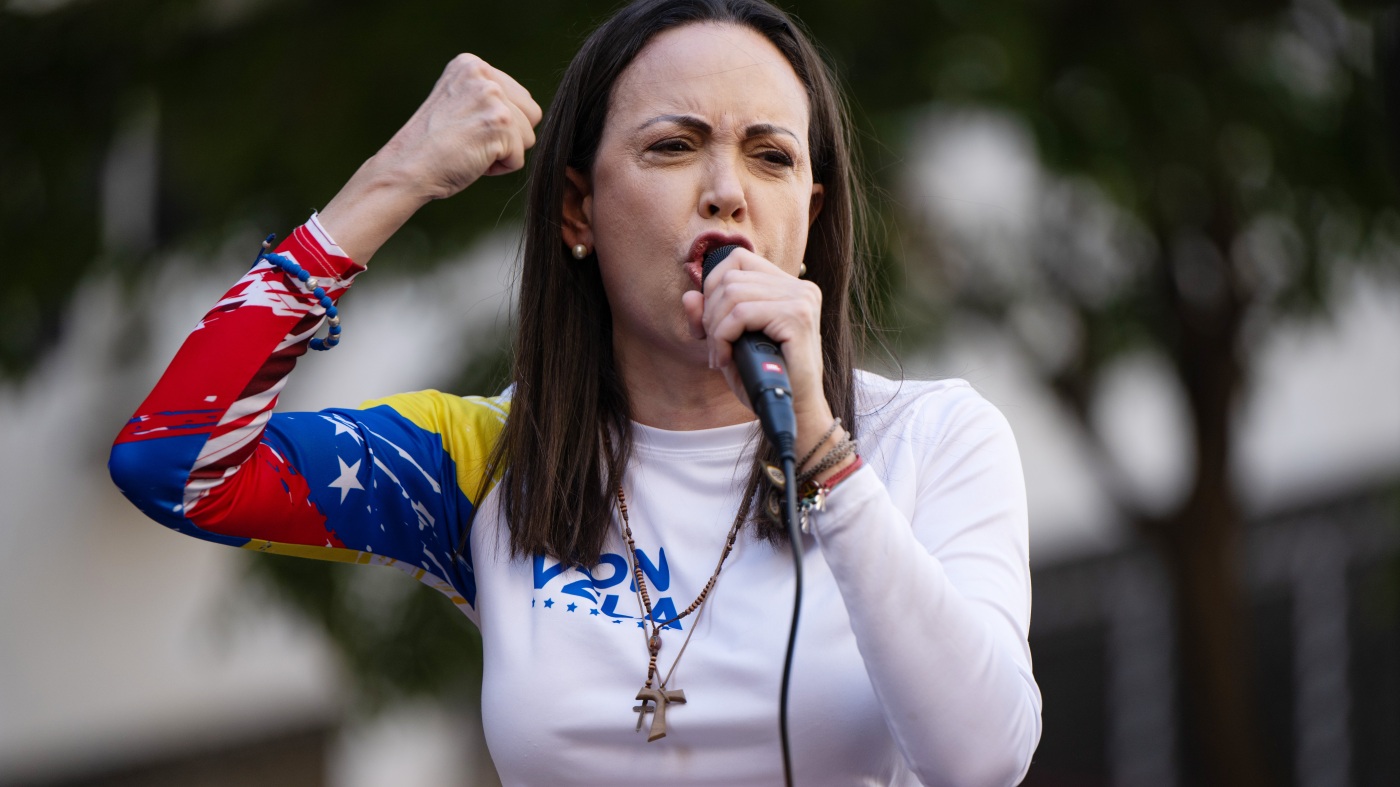Science
Chevron’s El Segundo refinery has a history of safety and environmental violations

The explosion and hours-long fire at Chevron’s refinery Thursday night in El Segundo deeply unnerved communities in the South Bay.
The blast sent shock waves throughout the refinery grounds, allegedly injuring at least one worker, and jolting residents as far as a mile away. A 100-foot-tall pillar of fire cast an orange glow over the night sky. And towering plumes of smoke and acrid odors drifted eastward with the onshore winds.
While local regulators are investigating the fire, environmental advocates lament that federal safety agencies likely won’t be joining in the effort to find the cause of Thursday’s explosion — perhaps preventing similar hazardous chemical releases in the future. The incident was one of the most perilous events in the refinery’s 114-year history, adding to a long list of environmental and safety violations, according to public records reviewed by The Times.
Most staff at the Occupational Safety and Health Administration, the federal agency tasked with investigating workplace safety, is not working because of the ongoing federal shutdown. The U.S. Chemical Safety and Hazard Mitigation Board, which determines root causes from dangerous chemical releases, is also furloughed and could lose its funding because of proposed budget cuts by the Trump administration.
“The Trump administration has defunded the Chemical Safety board, and the federal government is shut down right now,” said Joe Lyou, a resident of nearby Hawthorne and president of the Coalition for Clean Air, a statewide nonprofit. “So there is a very good possibility we are never going to know what really caused this, because the experts in figuring this stuff out are no longer there to do that.”
Without clear answers, labor unions are fearful that a similar disaster could endanger thousands of workers at California’s 15 refineries, which are mostly clustered in Southern California and the Bay Area.
“Companies are making billions in profits and still are making it nearly impossible to make sure we’re safe from terrible disasters,” said Joe Uehlein, board president of the Labor Network for Sustainability. “In California, we’ve seen horrific injuries to workers and tens of thousands of residents have had to seek medical attention in refinery accidents. This time, we got lucky.”
The Chemical Safety Board has identified causes of scores of refinery incidents over its history, including the 2015 explosion at the ExxonMobil refinery in Torrance that injured at least two workers.
In that incident, the board’s investigation found multiple safety failures, including a severely eroded safety valve that allowed flammable gases to dangerously seep into unwanted areas. The board also discovered that a large piece of debris almost struck a tank of hydrofluoric acid, which could have resulted in a deadly release of the highly toxic chemical, leading to pressure to cease using the chemical.
But, for the Chevron refinery explosion, there is no guarantee such an investigation will take place. The Trump administration proposed eliminating the budget for the Chemical Safety Board this fiscal year, starting Oct. 1, sunsetting the 27-year-old federal agency. Environmental advocates say that is a mistake.
“They’re undermining our ability to prevent these accidents by taking away the accountability mechanisms in the federal government,” said Lyou. “That’s a huge concern. It’s not politics. Democrats and Republicans live around the Chevron refinery, and they both want to make sure that the refinery is operating safely.”
In the absence of federal regulators, the South Coast Air Quality Management District is investigating potential violations of air quality rules and permit conditions. The refinery will also be required to submit a report analyzing potential causes and equipment breakdowns within 30 days.
So far, the air district has said the fire originated in the refinery’s ISOMAX hydocracking unit, which uses hydrogen to refine oil into jet fuel and diesel. The refinery’s air monitors detected a spike in airborne chemicals after the fire broke out, but air district officials say conditions returned to normal levels after a few hours.
Environmental advocates say the extent of the fallout may not be known until there is a larger examination of air quality monitors.
“I was very surprised that the air district reported they weren’t seeing terribly high levels of pollution,” said Julia May, senior scientist for California-based nonprofit Communities for a Better Environment. “Sometimes in a big refinery fire like this, it goes straight up. But then the smoke comes down in other areas. And that’s a lot of pollution that’s going someplace.”
The Chevron facility had been cited numerous times for environmental and safety violations, according to local and federal records.
The South Coast Air Quality Management District has issued 13 notices of violations over the last 12 months, and 46 in the last five years. Most recently, on Sept. 22, the air district cited the facility for a large chemical leak and failing to keep its equipment in proper working condition.
In August, Chevron representatives had also asked the air district for leniency in assessing compliance with air quality rules while it was working to remove unwanted buildup inside its furnace tubes — conditions that they said risked equipment overheating and potentially failing.
OSHA records show the agency conducted at least 15 inspections at the Chevron refinery in El Segundo over the last decade, identifying 17 violations.
In September 2023, OSHA issued citations related to heat illness prevention requirements, ladderway guardrails and a failure to conduct a thorough hazard analysis — an internal assessment intended to control fires, explosions and chemical releases.
In October 2022, after conducting a planned inspection of the Chevron refinery, OSHA records show the agency identified a “serious” violation of an agency standard requiring employers to “develop, implement and maintain safe work practices to prevent or control hazards,” such as leaks, spills, releases and discharges; and control over entry into hazardous work areas.
During the government shutdown, it’s unclear if OSHA’s pared-down staff will be investigating Thursday’s refinery fire. An OSHA media office phone number went straight to a recorded message stating that the line is not being monitored and “due to a loss of funding, certain government activities have been suspended and I’m unable to respond to your message at this time.”
For some environmentalists, the Chevron refinery fire has underscored why it’s necessary to transition away from fossil fuels altogether.
“They [the refineries] have great workers and great fire departments to respond, but this is an inherently dangerous operation that handles hundreds of thousands of barrels per day of flammable explosive materials under high temperature and high pressure,” said May, the senior scientist for Communities for a Better Environment.
“When something goes wrong, you can have a runaway fire. They did a great job at getting it under control. But do we really want antiquated dirty energy in our communities?”

Science
CDC announces change in COVID-19 and chickenpox vaccine recommendations

The new acting director of the U.S. Centers for Disease Control and Prevention has announced changes to the recommended vaccination schedule for adults against COVID-19 and for kids against chickenpox.
The changes were expected and were already previewed by recommendations made two weeks ago by the CDC’s powerful Advisory Committee on Immunization Practices. All members of the committee were recently replaced after Health and Human Services Secretary Robert F. Kennedy Jr. fired everyone on the previous panel earlier this year.
The CDC’s changes have been criticized by mainstream medical groups.
The CDC is now recommending that children under the age of 4 no longer get a combination vaccine that protects against four diseases: the chickenpox (also known as varicella), measles, mumps and rubella. Instead, the CDC now recommends two separate shots, one just against chickenpox, and the other that protects against measles, mumps and rubella.
The CDC has also now officially lifted its recommendation that adults under age 65 get the updated COVID-19 vaccine. The CDC now says the decision on whether an adult under age 65 gets a COVID-19 vaccine should be based on “individual-based decision-making” in consultation with health professionals like a physician, nurse or pharmacist.
This matches a change in recommendations made to the childhood vaccination schedule earlier this year.
The announcement was made by acting CDC director Jim O’Neill, a top deputy to Kennedy, a vaccine skeptic. O’Neill replaced Susan Monarez, who was fired as CDC director after 29 days on the job. Monarez said she was terminated after she pushed back against an effort by her bosses to undermine vaccines; Kennedy said she was fired because she said she was not trustworthy.
O’Neill has no training in medicine or healthcare and holds bachelor’s and master’s degrees in humanities, according to the Associated Press, and is a former investor who has been a critic of health regulations. He has previously worked at the Department of Health and Human Services, serving six years under President George W. Bush.
O’Neill’s announcement said that the changes will still allow for immunization coverage to continue through programs including the Vaccines for Children program, Children’s Health Insurance Program, Medicare and Medicaid.
The American Academy for Pediatrics in late September criticized the change, which removed the option for toddlers to get a single shot that can protect against chickenpox, measles, mumps and rubella.
The acting CDC director’s statement, issued by the press office of the Department of Health and Human Services, raised concerns about an increased risk of febrile seizure caused by fever after getting the combined chickenpox, measles, mumps and rubella vaccine (known as MMRV) versus those given the chickenpox vaccine separately.
The American Academy of Pediatrics said that in a meeting last month, some of the CDC’s new vaccine advisors “at times…misrepresented data and used talking points common among anti-vaccine groups. Some seemed unfamiliar with febrile seizures. They also disregarded CDC assurances that febrile seizures after MMRV are rare and do not have long-term impacts.”
The American Academy of Family Physicians recommends that all adults get the updated COVID-19 vaccine, especially those with risk conditions and people who have never gotten a COVID-19 vaccine.
The California Department of Public Health has slightly different guidelines. The agency recommends that adults younger than 65 with risk factors get the COVID-19 vaccine, as well as all adults who are in close contact with others with risk factors, and everyone who chooses to get vaccinated. The agency also recommends that all seniors get vaccinated against COVID-19.
Science
Majestic wild horses are trampling Mono Lake’s otherworldly landscape. The feds plan a roundup

Several dozen horses calmly graze along the shores of Mono Lake, a sparkling saline expanse spread out before the jagged Sierra Nevada. The September sun is blazing. A pair of brown horses come up side by side and stare intensely at an approaching visitor.
These wild equines soon may disappear from beside the ancient lake. The prospect is stirring emotional disagreement over the future of the herd, which has surged to more than three times what federal officials say the land can support.
-
Share via
“These horses deserve a place to roam and be free, but around Mono Lake is not the place,” said Bartshe Miller of the Mono Lake Committee, an environmental nonprofit.
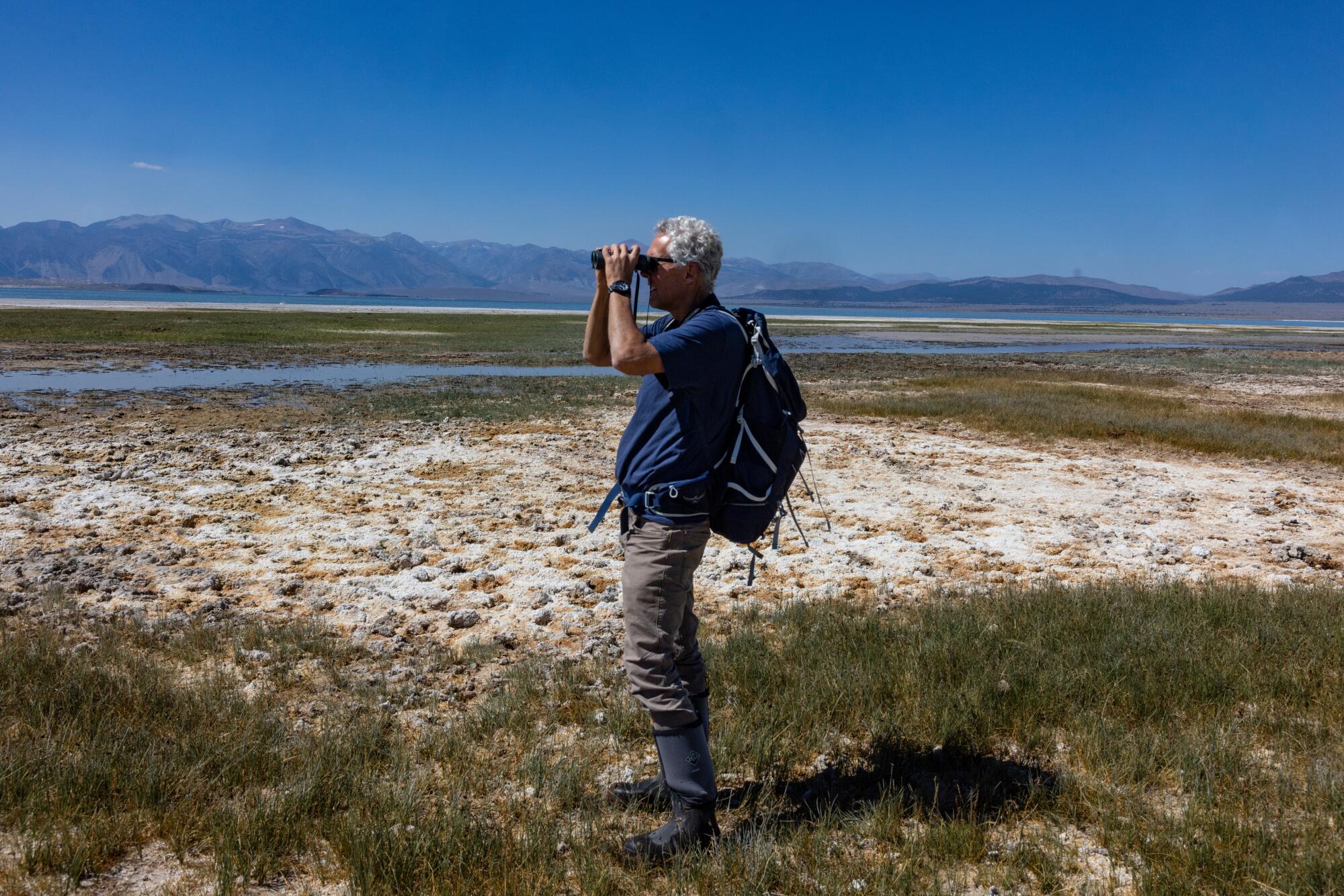
Bartshe Miller, Eastern Sierra policy director for the Mono Lake Committee, looks out onto the landscape at Warm Springs, a remote area on the east side of Mono Lake.
This year, the U.S. Forest Service and Bureau of Land Management approved a plan to round up and remove hundreds of wild horses roaming beyond the roughly 200,000 acres designated for them along the California and Nevada border. No date has been set, but it could be as soon as this fall.
It would be a relief for some. Environmentalists say the horses are degrading the otherworldly landscape at Mono Lake, including bird habitat and its famed tufa — textured rock columns that would look at home on Mars. Ranchers say the animals are gobbling down plants needed to sustain their cattle. Federal officials highlight the safety hazard posed by horses that have wandered onto highways.
Others see the move as a travesty. One method to oust the horses would use helicopters to drive them into a trap, which animal welfare groups say creates dangerous, even deadly, situations for horses. A pending federal bill would ban the practice.
Local tribes and nonprofits have partnered to fight the roundup plan, arguing that the Indigenous community should be tapped to manage the animals that roam their ancestral lands. A separate group of plaintiffs has sued the government, claiming it’s reneging on its duty to protect the horses.
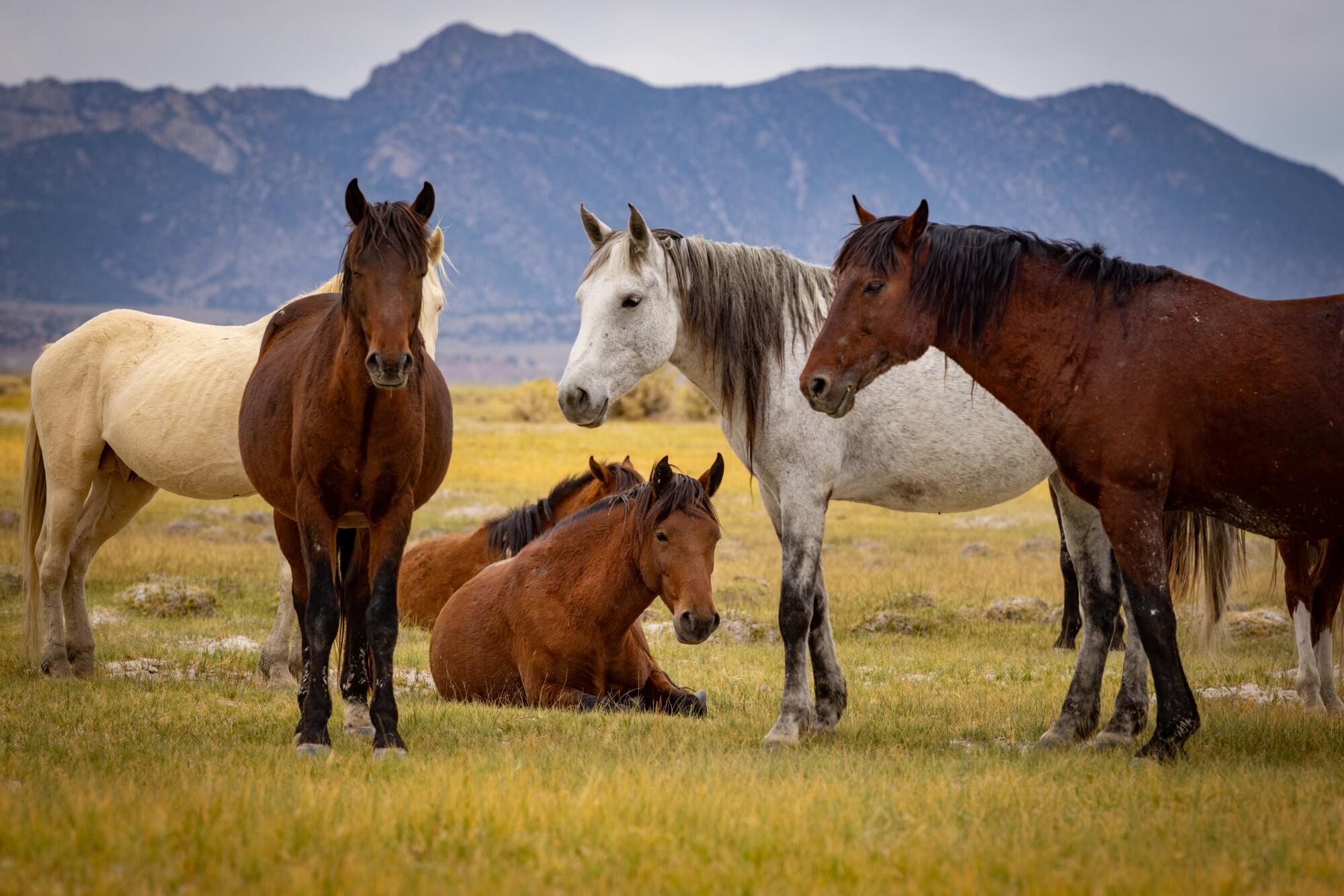
A group of horses roams near the community of Benton, Calif., not far from the Nevada border.
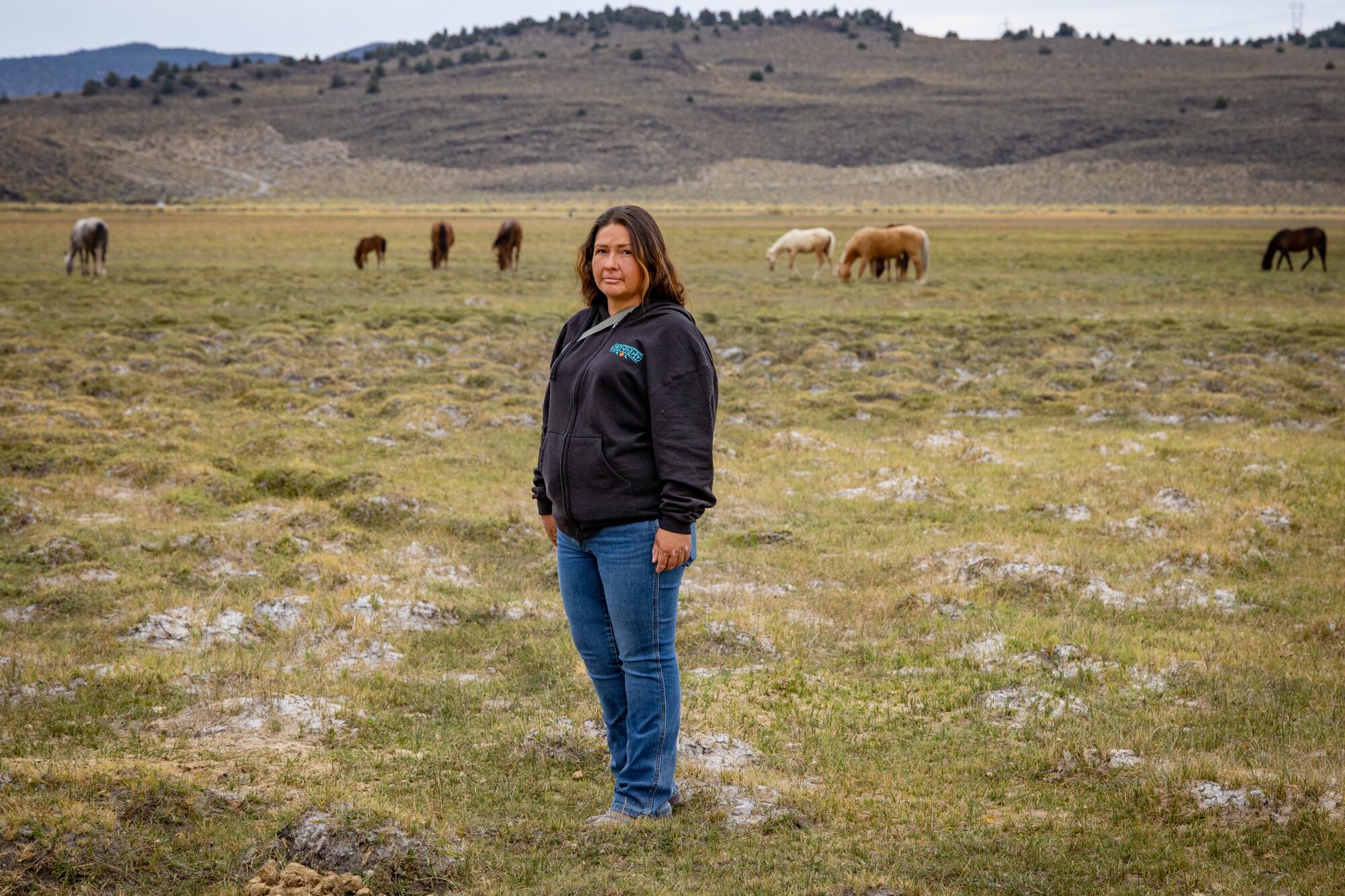
Ronda Kauk, of the Mono Lake Kootzaduka’a tribe, stands near wild horses.
“We’re all living spirits,” said Ronda Kauk, a member of the Mono Lake Kootzaduka’a tribe. “And it’s sad that people just don’t care about another living thing because they think it doesn’t belong there.”
Unseen evolution
For 36 years, Dave Marquart was part of a small team that monitored wetlands rimming Mono Lake, places so inaccessible even four-wheel drives can get stuck. Flung out far on the landscape, only wildlife could enjoy them. The area was a major nesting site for yellow-headed black birds, red-winged black birds, marsh wrens, soras and Virginia rails.
“There weren’t a lot of people that saw the transition that I saw, from healthy wetlands to completely trampled and devastated wetlands,” said Marquart, who was an interpretive naturalist for the Mono Lake Tufa State Natural Reserve until he retired in 2019. “It was quite a drastic change.”
Marquart recalled a time when he’d encounter fewer than 50 horses. They’d bolt when they saw his vehicle coming. That fear faded and their ranks grew. Over time, he said, they stamped ponds and urinated and defecated in the water. The birds stopped showing up.

Bartshe Miller holds grass he said was pulled up by the roots by wild horses roaming near Mono Lake. According to Miller, horses started arriving near the lake around 2015.
Before retiring, Marquart said, he helped organize a field trip involving the Forest Service, BLM and State Parks to showcase the impacts.
“Everybody saw that it was an issue and felt that something needed to be done,” he said.
Today, sizable mounds of horse manure dot Warm Springs, a remote area along the eastern edge of Mono Lake that Marquart had raised the alarm about during his tenure. White bones of fallen equines rest in the alkaline meadows. Chestnut fur gleamed on a hoof attached to a leg bone.
Miller, the Mono Lake Committee’s Eastern Sierra policy director, and Geoff McQuilkin, its executive director, led the way to a burbling spring rimmed by innumerable hoof prints. Surrounding vegetation was nibbled to nubs. Wildlife compete for the limited water here.

The bleached bones of a wild horse lie in vegetation near the shores of Mono Lake.
“The birds that would have a safe haven in that spring or be hidden away from raptors and predators overhead don’t have that opportunity anymore,” McQuilkin said.
The pair first remembered the horses showing up in remote areas around the lake in 2015, as the state was gripped by drought. By 2021, as they pushed west, they landed at South Tufa, where tourists congregate to gaze at the limestone columns. In the spring of 2023, horse carcasses emerged along the shores of South Tufa and nearby Navy Beach as the snow from a winter of biblical proportions melted.
“The recent deaths of these horses provide further evidence that the size of this herd cannot be supported by the landscape which they are expanding onto,” Lisa Cox, a spokesperson for the Inyo National Forest, said at the time.
‘They’re medicine’

Rana Saulque, vice chairwoman of the Utu Utu Gwaitu Paiute tribe, walks near a natural spring in an area where wild horses gather near the community of Benton, Calif.
On a pleasantly cool day in September, Rana Saulque stared transfixed at a group of roughly 50 wild horses in the River Spring Lakes Ecological Reserve, not far from her tribe’s reservation near the town of Benton.
Saulque, vice chairwoman for the Utu Utu Gwaitu Paiute tribe, draws a parallel between ousting the horses and the historical persecution of her people by the government.
“They’re going to run them down with helicopters and genocide them, just like they ran down us,” she said through tears.
A striking cremello horse stood out from the rest — a beloved subject for photographers who sojourn here. A brown foal with a white stripe on its muzzle teetered on toothpick legs. Several babies hugged close to their moms.
Mostly, the horses peacefully graze, but two rear up momentarily. “That’s horsing around,” Saulque said. Then they begin galloping and suddenly they look powerful and sleek. Epic, like a poster for a classic western film.

Dozens of wild horses graze on the River Spring Lakes Ecological Reserve.
“They’re so magical,” the vice chairwoman said. “They’re medicine for people.”
Federal officials stress that they have precautions in place to ensure safety during helicopter roundups. That includes avoiding peak foaling periods and hot weather that would stress the horses.
The Utu Utu Gwaitu Paiute are among a coalition that wants to pause the planned roundups for two years and ultimately secure land back to set aside a sanctuary for the horses to roam. As envisioned, local tribes would help manage the herd, including darting horses with a birth control vaccine to limit population growth. Horses could be put to work at pack stations, equine therapy and rodeo schools for kids, the group says.
The proposal could also help revive horse culture that runs deep in the tribal communities, Saulque said. Jim Walker, her great-great-grandfather and a respected medicine man, rode mustangs all the way to Florida, visiting tribes along the way to exchange medicine and horses.
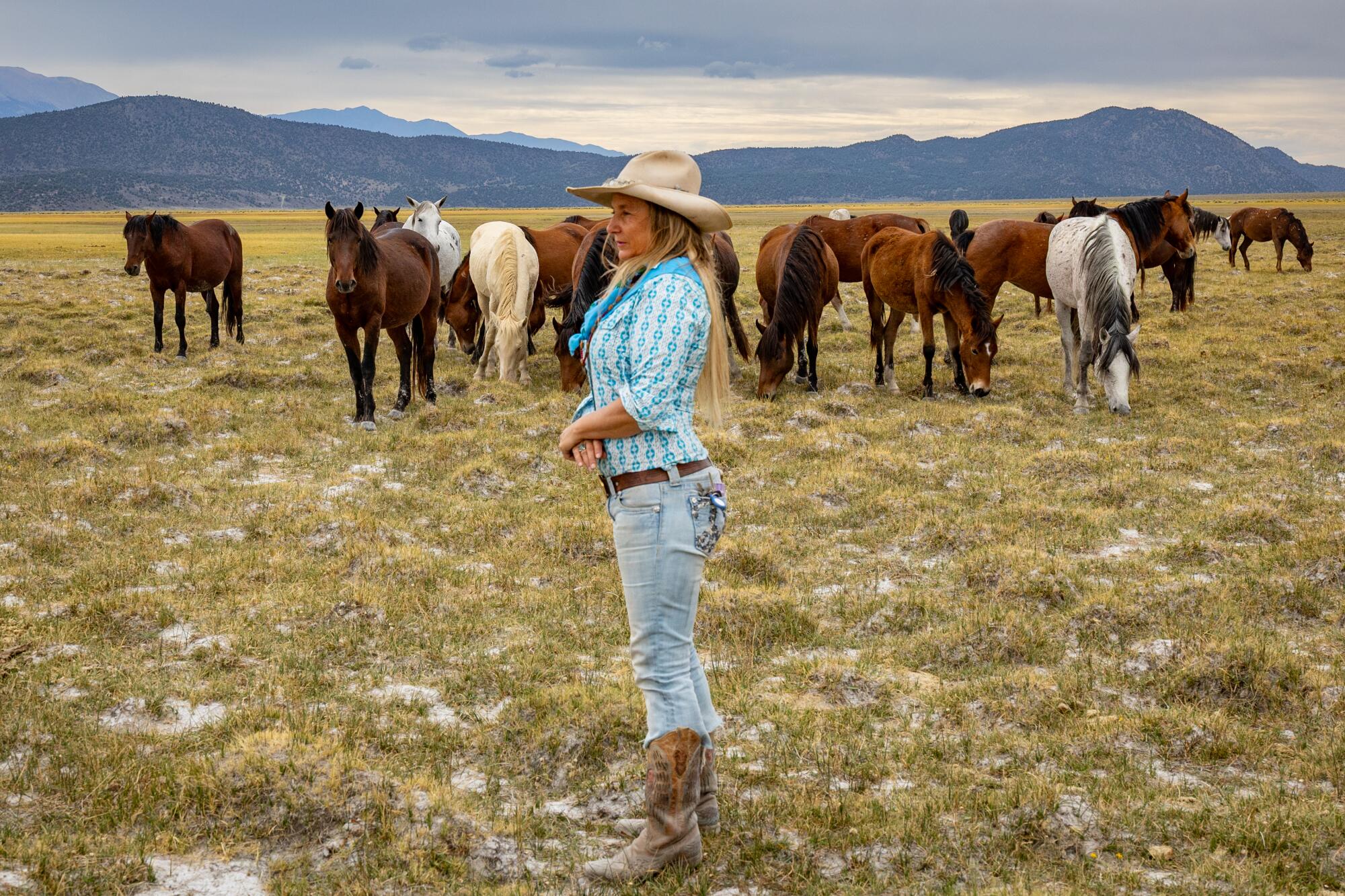
Maya Jamal Kasberg, founder of nonprofit Made by Mother Earth, is part of the coalition that wants to scrap the current plan to round up Montgomery Pass horses.
Kauk’s tribe historically rode the horses from Lee Vining into Yosemite to gather basket-making materials, among other activities. Mustangs were tapped for Native American rodeos and relay races, she added.
According to the coalition that includes the nonprofit American Wild Horse Conservation, federal officials and groups like the Mono Lake Committee have the science all wrong. The herbivores chomp down invasive cheatgrass that poses wildfire risk, and their poop — maligned by many — actually spreads native seeds, they say.
Wild and free — for now
At the heart of the emotional battle playing out in the Eastern Sierra is the Montgomery Pass wild horse herd. According to the U.S. Forest Service, its origin is unknown. But there’s speculation that it’s linked to mustang drives between the Owens Valley and Nevada.
A 1971 law declared wild horses and burros “living symbols of the historic and pioneer spirit of the West,” and made it illegal to harass, capture or kill them on public lands. But the Forest Service and BLM, which became responsible for managing them, can remove “excess animals” to preserve the health of the range.
The way this often plays out is that horses are rounded up and offered for adoption or sale. Those that aren’t taken in by a private owner are shipped to pastures where they often live out their remaining days.
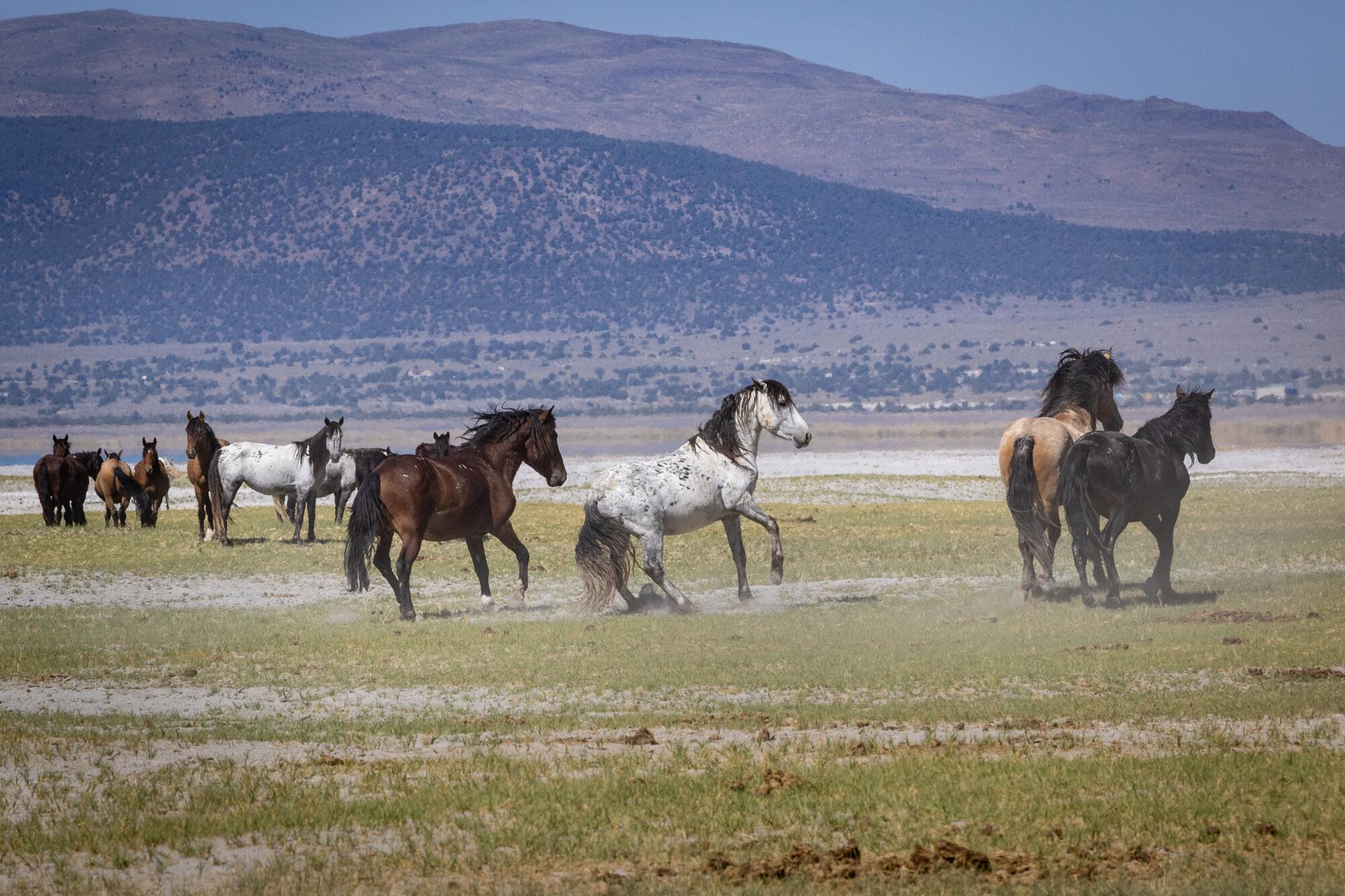
A census last year found that there are now about 700 horses in the Montgomery Pass herd.
Federal officials designated the Montgomery Pass Wild Horse Territory, a remote area spanning sagebrush steppe and pinyon pine forest east of Mono Lake. They say the land can sustainably support 138 to 230 horses.
As of last year, nearly 700 were documented in an aerial survey, with most ranging outside the territory, according to the agencies.
Now under a plan approved in March, up to 500 horses could be ousted, with the Forest Service leading the effort and BLM assisting.
Both agencies declined requests for interviews for this article, citing pending litigation. In August, a documentary filmmaker, primary care physician and wildlife ecologist sued the government authorities overseeing the agencies, claiming the roundups will decimate the herd to the point where long-term survival is unlikely.
“This case represents yet another attempt by the agencies to evade their statutory duties to protect, preserve and manage the herd,” the suit reads.
The government has agreed not to round up horses before Oct. 20, according to court documents.
When multiple uses collide
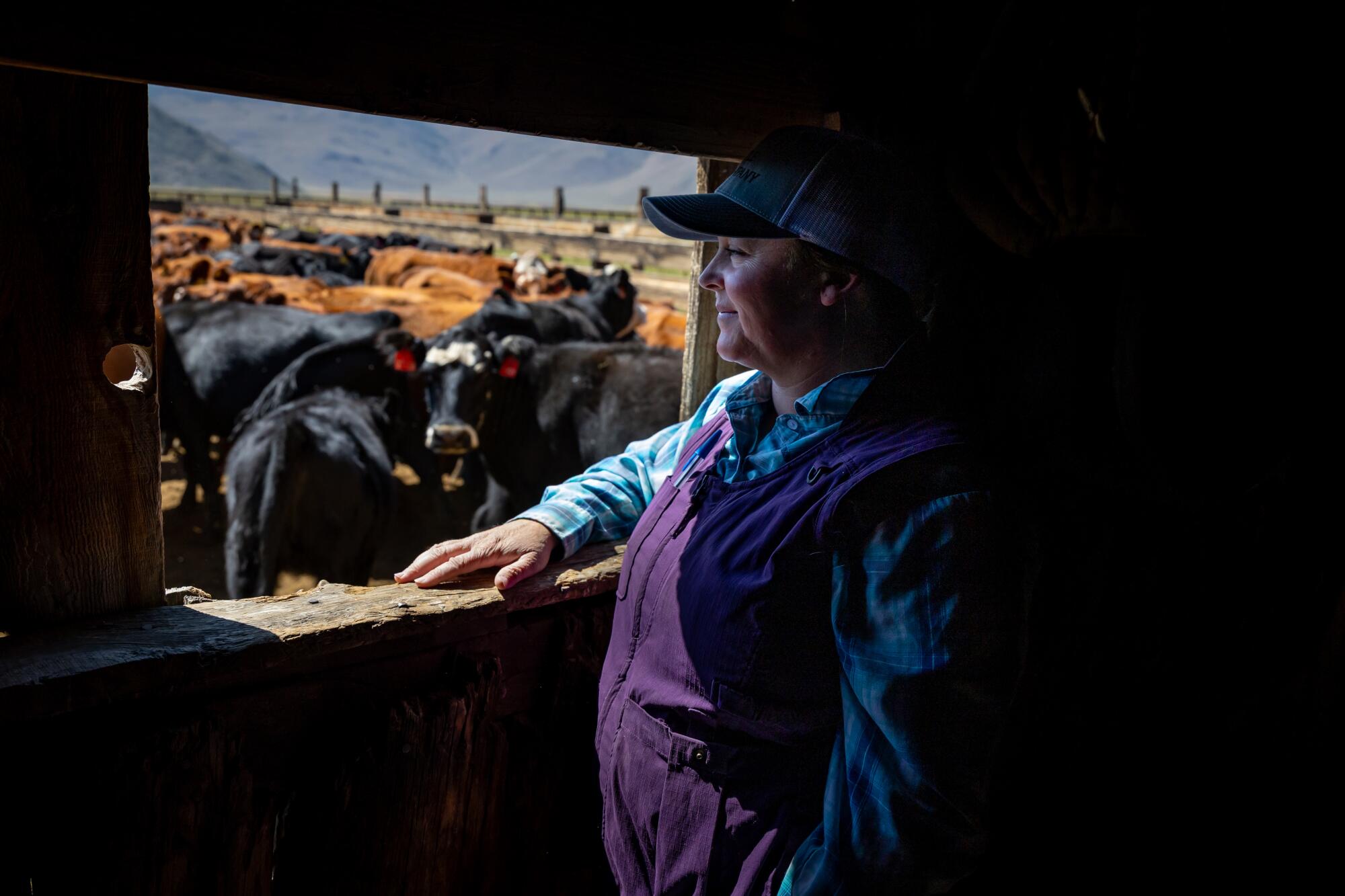
Rancher Leslie Hunewill looks at calves and their moms at her family’s historic ranch in Bridgeport.
Leslie Hunewill’s cattle ranching family sees quite a bit of “horse activity” on grazing lands in an area called the Mono Sand Flats, to the east and north of the lake. Since purchasing the right to use the public land, her outfit has been able to graze there for only about five weeks in the last two years — and not consecutively. The culprit? “A huge number of horses,” she said.
“Our cattle have not been out there,” she said. “There’s nothing for them to eat.”
Cows aren’t allowed on the roughly 50,000-acre expanse during the growing season. But the horses, facing no fences, go for what’s green and pushing up, she said.
“It doesn’t make sense for us to overuse or overgraze the land when we need to come back to it,” she said. “So when we are doing our part to manage the portion of it that we can, which is, say, our use of the cattle on that land, that’s all well and good. But who is taking charge of the horses and saying, this is too heavy use?”

The Hunewills, who have deep roots in the Eastern Sierra, operate a guest ranch in Bridgeport.
The law directs agencies to manage horse populations to maintain a “thriving natural ecological balance.” BLM and the Forest Service have to consider mustangs alongside grazing, wildlife and what’s good for the land. Some say the agencies have kicked the can down the road on management of the Montgomery Pass herd.
Hunewill’s family has deep roots in the Eastern Sierra. Her great-great-great-grandfather came to California in the 1860s as a gold miner. He struck it rich and got into the lumber business. When that stopped paying out, he used his oxen to feed the town of Bodie.
Her family is still in the beef business, with the meat generally staying on the West Coast.
They employ quite a few mustangs at their guest ranch operation in the town of Bridgeport, including Jethro, a friendly brown fella with a splash of white on his forehead. They’re hardy horses and can be enlisted as pack animals high up in the mountains. Some don’t need shoes because of their “great feet.”
But their robustness means “everybody’s already got their mustang,” she said, stymieing the prospect of mass adoptions.
Shifting dynamics
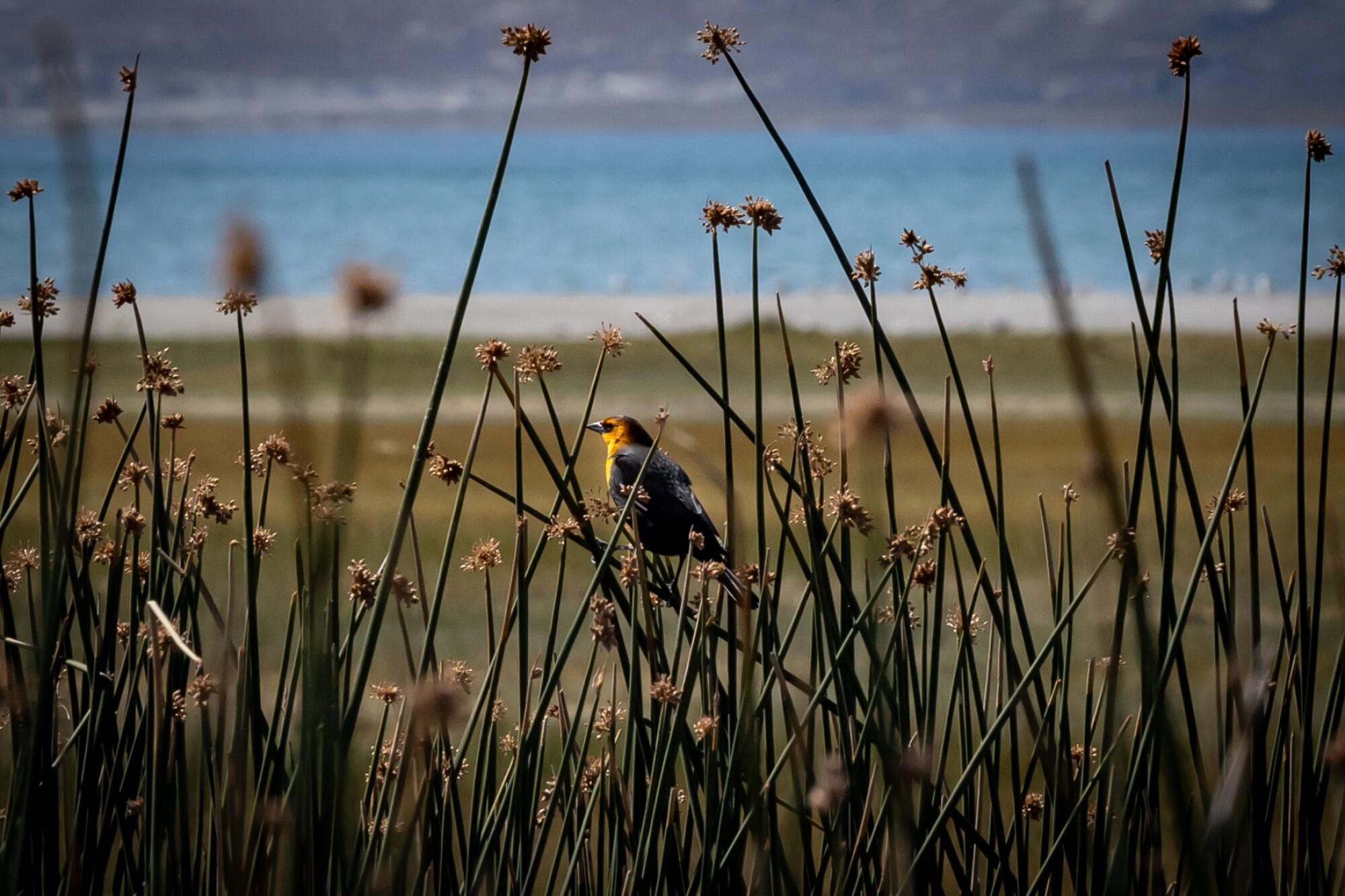
A bird perches in vegetation near Mono Lake.
Wild horse populations can increase as much as 20% a year. Montgomery Pass horses used to summer in the high country and were once kept in check by mountain lions that preyed on foals, according to John Turner, a professor at the University of Toledo College of Medicine, who studied the herd for decades.
That changed around 2008 or 2009, when the horses began lingering at lower elevations, where the open country makes it difficult for lions to hunt.
The herd’s population surged.
Turner sees the government’s current system of rounding up horses and holding them as unsustainable. And costly.
“The gathers are successful at that time, but the reproductive rate of the animals is greater than the capacity to remove them,” he said.
Science
An L.A. AIDS trailblazer has advice on how to stay hopeful in dark times for public health

The year was 1987. Phill Wilson was 31, a recent transplant to L.A. from his hometown of Chicago. A mysterious infection that weakened its hosts’ immune systems was killing people at a terrifying rate, while the Reagan administration downplayed and openly joked about the disease. Some major news outlets initially wrote off the emerging epidemic as a “gay plague,” insinuating that other Americans didn’t need to worry about it.
Wilson’s doctor told him that he was HIV-positive, had six months to live and that he should get his affairs in order.
Instead, Wilson decided to “focus on the living.”
“Let’s use the time I have to do something,” he recalls thinking.
“My life,” Wilson says now, at age 69, “is that something.”
Wilson went on to found L.A.’s Black AIDS Institute, using the nonprofit think tank to draw attention to the lack of outreach, prevention and treatment programs tailored to Black Americans — despite the disproportionate toll that AIDS had taken on them.
Wilson not only defied his doctor’s orders. He also defied the odds, surviving one of the world’s deadliest epidemics, along the way preaching the message of prevention and care, from demonstrations in the nation’s capital to the sanctified realm of the Black church.
A participant holds a sign referring to Rock Hudson during a three-hour walkathon through Hollywood on July 28, 1985, in a fundraiser sponsored by AIDS Project Los Angeles.
(Jim Ruymen / Associated Press)
It’s been 40 years since Angelenos took to the streets for the first time to raise money for research in the wake of screen legend Rock Hudson’s stunning announcement that he had AIDS in 1985. That’s why it’s so hard for Wilson to accept that today, as L.A. is set to hold its annual AIDS Walk on Oct. 12 in West Hollywood, a new era of death and grief could be on the horizon.
Just as success appears within reach to end fatalities from HIV/AIDS worldwide, the U.S. — the global leader in that battle — seems to be in retreat.
In recent months, Republicans in Congress have followed up on moves by the Trump administration by calling for deep cuts to federal funding for HIV/AIDS prevention and home treatment, leaving public health officials and LGBTQ+ nonprofits in L.A. and elsewhere with few options besides cutting staff and suspending programs. AIDS organizations worldwide are also alarmed over the administration’s gutting of foreign aid initiatives for nations in Africa and elsewhere that cannot afford to fight infectious diseases on their own.
Wilson worries that 40 years of work that he and other activists, public health experts and providers, and members of the LGBTQ+ community have done to mobilize will be reversed in the space of a presidential term.

Phill Wilson reflects on the friends who lost their lives to AIDS while standing next to what he calls “My Wall of Dead People.”
(Genaro Molina / Los Angeles Times)
“I never imagined that I would be 69; I never imagined that I would still be alive and healthy,” Wilson said. “And I also never imagined that the trajectory of the AIDS pandemic would take us from malicious neglect, during the Reagan years, to a powerful movement that changed the trajectory of treatment and care and prevention not just for HIV and AIDS but for chronic diseases and infectious diseases in general, to … a day when in fact our government was actively engaged in dismantling institutions and systems that … were actually saving lives.”
Wilson, who also sits on the board of trustees at amfAr, one of the top AIDS research foundations, has been lauded by Republican and Democratic presidents. He has also attended the funerals of too many friends killed by the disease to count — giving him both a global and a painfully personal perspective on a disease that has infected more than 88 million people and claimed more than 42 million lives worldwide, according to the 2024 L.A. Annual AIDS Surveillance Report.
AIDS-related illnesses have killed at least 30,000 people in Los Angeles County alone, according to a report from the county’s Commission on HIV.
There is still no cure for AIDS. But since the introduction of powerful antiretroviral drugs in the 1990s that allow those infected to continue living healthy lives — and more recent preventative treatments such as PrEP — fatalities have plunged. In 2020, the U.S. government set a goal of reducing AIDS fatalities by 90% over the following decade.
But a team of researchers from UCLA and other institutions recently concluded that the Trump administration’s plan to shutter the U.S. Agency for International Development, a foreign aid program, and rescind already-appropriated funding to it could lead to millions of people dying of HIV/AIDS over the next five years who could have been protected through HIV outreach, testing and lifesaving drugs.
“With the current policies in place, there is a very good chance that we’re going to see a huge spike in new infections and we’re going to return to the days of people dying of HIV and AIDS when that’s preventable,” Wilson said.
Closer to home in L.A., the successes have been uneven.
The racial disparities that sparked Wilson’s activism at the dawn of the pandemic have narrowed but still exist.
Black Angelenos make up just 8% of the county’s population but represented roughly 18% of HIV cases recorded between January 2023 and December 2024, the most recent period for which sufficient data were available on the county’s public health dashboard. Latinos made up about 60% of cases, though this group constitutes 49% of the county’s population.
Wilson doesn’t need these grim statistics to remind him of the stakes involved if HIV/AIDS funding gets cut.
His partner, Chris Brownlie, was diagnosed with AIDS in1985, and after four years of suffering, died of the illness. That wrenching experience prompted Wilson to become an activist full time.
Wilson survived his own near-death illness stemming from AIDS in 1995, thanks to a new treatment that kept the virus from replicating. By then he had grown used to attending AIDS vigils and delivering eulogies for others who died too soon. Eventually he became AIDS coordinator for the city of Los Angeles and director of policy and planning at AIDS Project Los Angeles, now called APLA Health.

Phill Wilson, founder and former head of the Black AIDS Institute, meets President Obama.
(Courtesy of Phill Wilson)
Today, Wilson’s home radiates with colorful artworks from his private collection and vibrant African wood carvings climbing toward the loft ceiling. There are pictures of him shaking hands with Presidents George W. Bush, Clinton and Obama.
Facing Wilson as he speaks is a Kwaku Alston portrait of late South African President Nelson Mandela, commissioned when Wilson persuaded that nation’s first Black president to sit for a portrait session to celebrate him being honored by the Black AIDS Institute.
Situated among these bursts of color and patterns and Afrocentric pride, though, are photos of unspeakable losses.
It’s chilling to see the many images of fallen Black gay men — among them the poet and activist Essex Hemphill; Marlon Riggs, maker of a seminal 1989 film on the Black queer experience “Tongues Untied,” and the South African anti-apartheid and AIDS activist Simon Nkoli, who helped organize Africa’s first Pride march in 1990 — and realize how many of Wilson’s brothers in spirit and in struggle were cut down by the disease in their prime.
“My nephews call this wall my ‘Wall of Dead People,’” Wilson said, “because so many of the photographs are of people who are no longer with us, or photographs where I’m the only one alive.
“My motivation is to keep the memories of all of my friends who we lost during the AIDS pandemic alive,” he said, “to remind people that they were here, and they meant something and did work and they had lives and they had loves.”

Standing in front of a piece by artist Woodrow Nash, Phill Wilson describes the art that fills his home in Los Feliz.
(Genaro Molina / Los Angeles Times)
Wilson remembers how hard it was at first to promote HIV/AIDS awareness in L.A.’s Black community.
He had grown frustrated with the limited breadth of AIDS outreach in the 1980s and ‘90s. The whole model seemed too “white centric,” conspicuously lacking in outreach that took into account the obstacles that queer people of color faced. It was daunting enough to come out as gay in some Black and brown households, let alone speak openly about a deadly epidemic whose uncertain origins had fueled wild, often-racist conspiracy theories suggesting that Black people were chiefly responsible for its spread.
The idea of inviting LGBTQ+ advocates into your home to talk about prevention may have worked in settings where gay men were affluent (and mostly white), but many lower-income queer Angelenos (many of whom where nonwhite) still lived with their families.
He knew he needed an “unapologetically Black” game plan, which included co-founding the National Gay and Lesbian Leadership Forum, an organization whose meetings allowed Black AIDS activists in L.A. and other cities to network and exchange best practices with peers who looked like them and could relate to their life experiences.
Wilson, who grew up in the projects of Chicago’s South Side and attended a Black church, also tried to enlist L.A.’s Black pastors to help spread the word about AIDS in their neighborhoods. It was slow going at first.
He recalls breaking with protocol at one Black house of worship by taking to the raised lectern — traditionally the exclusive domain of the preacher — to warn worshipers about the risks of ignoring the deadly disease killing their sons, brothers, nephews and nieces.
His stern address was mainly met with silence. But as Wilson walked toward the exit, minister after minister held out a hand to take one of the educational fliers he’d brought to hand out.
“They already knew that AIDS had visited their churches,” Wilson said.
In July, Wilson was struck again by memories of days gone by when Jewel Thais-Williams, the founder of the legendary Black queer club Jewel’s Catch One on Pico Boulevard, died at age 86.
Wilson remembers when the club, now a mixed venue, was known as a sanctuary for the city’s Black and brown queer community. Williams presided as a surrogate mother and life coach for Black gays and lesbians, transgender Angelenos of color, people living with HIV who felt stigmatized because of their status, and those who didn’t necessarily feel at home in mostly white venues. Williams had also established the first housing complex in the U.S. for Black women living with HIV and their children and started a holistic wellness clinic for members of the city’s Black and brown communities.
Wilson attended Williams’ public memorial at “The Catch” in August, alongside hundreds of friends, loved ones, politicians, former drag performers and club staffers. Some older club patrons strode in with the aid of walking sticks, less agile than they used to be but determined to pay their respects to “Mama Jewel.”
Everyone dressed as if for Sunday morning service — but the event morphed midway into a Sunday afternoon tea dance, with the crowd grooving under the disco balls to gospel-inflected house music, evoking the roof-raising atmosphere that made the club famous back in the day.
Wilson took to the stage to pose with L.A. Mayor Karen Bass as she presented a proclamation declaring the club a historical landmark.
In some ways, that moment of light seems like a long time ago. The current situation for public health in L.A. and across the country feels much darker.
That said, Wilson has learned to find solace in times of sadness and dread by taking the long view.
Having weathered the Reagan administration’s negligence, twice outlived his own death sentence in the AIDS crisis and recovered from a stroke two years ago, he has no patience for those who wallow in hopelessness about the federal cuts.
What people must do now, Wilson says, is the same thing that catalyzed him and local leaders such as Williams in the initial war against AIDS: Find ways to help, refuse to be silent and heed a piece of advice that may not sound satisfying in the moment but has sustained him through bouts of indignation and grief: “This too shall pass.”
Wilson realizes that, much like in the ‘80s, not everyone in the queer community or society at large feels personally invested in the fight against HIV/AIDS. For them, he has another bit of wisdom: Just because a government engaged in upending practices and slashing programs has yet to attack you or those you love doesn’t mean you should be a bystander to the damage done to others.
Wilson recites a James Baldwin line from his “Open Letter to My Sister, Miss Angela Davis”: “For if they come for you in the morning, they will be coming for us at night.”
“We may not know it,” Wilson says, “but we all have skin in the game.”
-

 Wisconsin3 days ago
Wisconsin3 days agoAppleton Public Library wins 2025 Wisconsin Library of the Year award for distinguished service
-

 Vermont3 days ago
Vermont3 days agoFeds: Springfield dealer ran his drug business from Vermont jail
-
Virginia3 days ago
Match 13 Preview: #8 Virginia
-
Business2 days ago
Los Angeles Times Media Group takes step to go public
-

 West Virginia3 days ago
West Virginia3 days agoWest Virginia eatery among Yelp’s “outrageous outdoor dining spots”
-
Utah3 days ago
Bookmark this link for The Southern Utah Tribune e-edition
-
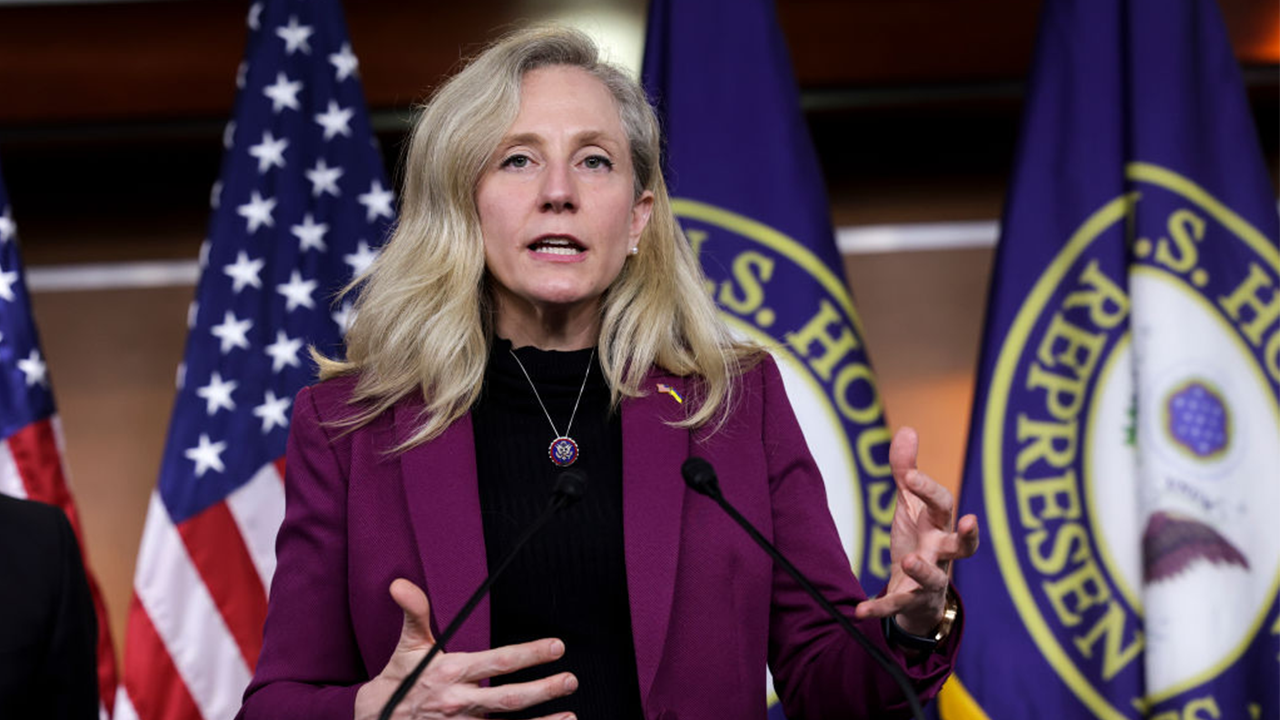
 Politics2 days ago
Politics2 days agoSpanberger refuses to urge Jay Jones to exit race, dodges questions after ‘two bullets’ texts
-

 Midwest2 days ago
Midwest2 days agoWisconsin ski park faces lawsuit after allegedly firing employee for sharing Bible verses on social media



